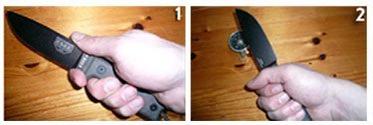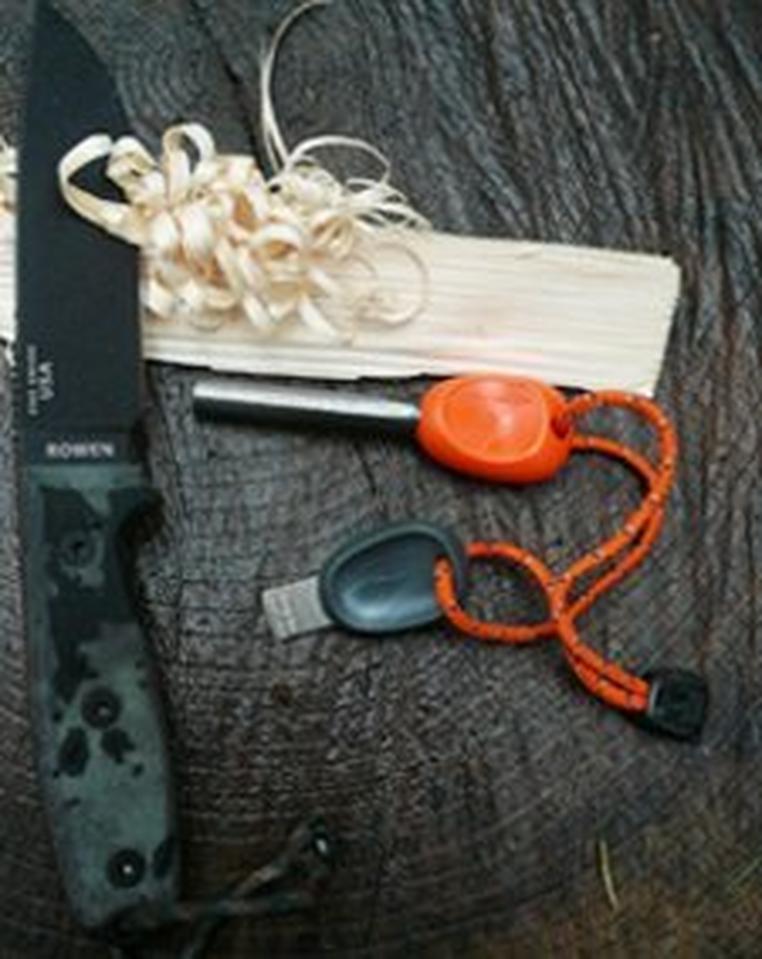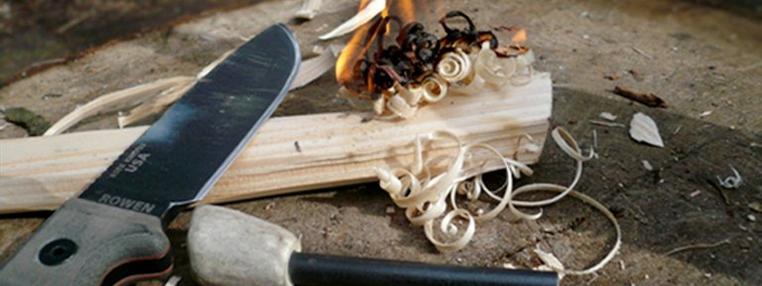ESEE model 4P-KO Review
ESEE knives, formerly known as RAT Cutlery, are produced in America by Randall's Adventure & Training. Before they bring a new ESEE-model on the market, it will be tested by several experienced users. A knife is subject to tests in different outdoor situations , in the jungle, the desert area and in a polar climate. Then, when the knife is adjusted according to the feedback by the users and to all other requirements, it is brought on the market.
By testing all its knives, Randall’s Adventure & Training guarantees the high quality of ESEE-knives. This also enables them to offer a lifetime warranty on the knives. It doesn't matter how many owners the knife has had, or if the proof of purchase can be shown. Normal wear and tear and rust are never covered by warranty.
First impression
The knife that I have chosen for this review is the ESEE-4 P-KO. This knife has no saw edge and has solid gray micarta scales, with orange liners.
For the sheath, I chose an ESEE-50B, combined with the Blade-Tech Tek-Lok belt clip. As an extra with the knife, ESEE supplies a card with some survival tips, ground- to airsignals and a conversion chart for American to European distances.
When I first saw the ESEE knife, I was instantly excited. The tough, military look of the knife, almost makes you want to jump in the car to go get a matching military uniform at the nearest dump.
The knife feels very solid and lies comfortably in your hand. However, I must mention that the handle is quite short. You have about 9 cm for placing your hand, measured from the finger guard. However, for my middle sized hands (8.5 cm from my little finger until my index finger) this is no problem. The coating of the knife feels very durable and is way better than anything I've experienced with other coatings.
What stands out immediately, is the pretty hefty weight of the knife (207 grams). This indicates that the tang (the handle) of the knife is not skeletonized (thinned out, to save weight). The balance of the knife is a few mm beside the finger guard.
The back of the knife features jimpings, these must provide an extra grip and control over the knife. You find these at the end of the blade, against the handle. In many cases, jimpings are aggressive and painful to your fingers. But this is not the case with the ESEE knife. The jimpings are neatly rounded, so they feel quite comfortable, even when exercising a lot of pressure on them.
Sharp from the box
I'm positive about the sharpness of the knife out of the box. The knife is, out of the box, sharp enough to easily shave the hair off my arm. This is definitely not a standard with most knife manufactureres. Often, knives are just sharp enough to cut some paper. The ESEE sharpness out of the box, can be compared really well to an unused Mora knife.
The secondary V-edge has an angle of about 20 degrees on each side, which provides an excellent balance between sharpness and firmness of the edge.
For this, I rate the knife with an 8 out of 10
Comfort of the handle
I think the knife is comfortable to hold, at least with the following handles:
- Handle 1: For this handle. you use your index finger in the recess of the blade. This gives good control over the knife, which is effective for carving or feather sticking.
- Handle 2: The so-called "reverse grip ' also feels comfortable. This handle is often used when, for example, you have to make a pointy end to a stick.
- Handle 3: This handle is most used handle for a knife of this type of caliber. The jimpings at the back of the blade provide a good grip, which gives you extra control over the knife. The jimpings feel comfortable and do not cause pain to your fingers.
- Handle 4: This handle is named 'Side holding' and is often used for boning. The thin ESEE handle makes this a very comfortable handle.
The micarta handle is not polished. This provides good grip and a rugged look. The handle does absorb moisture. As a counter measure, you can treat the handel with linseed oil or Danish Oil. However, this does make the colour of the handle a bit darker.
Including the fact that the handle is quite short, I rate the handle a 7.5 out of 10.
Quality of the sheath
The kydex sheath by ESEE is of good quality and suitable for both right- and left handed users. You sometimes hear stories about kydex sheaths blunting a knife. This is not the case with ESEE. I've removed the knife from the sheath about a 100 times, without noticing any change to the sharpness of the edge. A convenient feature of this sheath, is that the friction can be adjusted to your own preference. If you prefer a lot of friction between the sheath and knife, you can remount the top screw in the sheath to the top hole for this. The knife fits firmly in the sheath and there's no risk that this will fall out. Despite the good retention, it's easy to take the knife from the sheath.
The advantage of kydex sheaths is that these are often easy to modify. As an example, I added a firesteel holder to the sheath, which is essential in my opinion. For this holder I have used a simple hose clamp. The sheath can also be easily modified to add a Maxpedition Single Sheath (holder for a multi tool).
To secure my sheath to my belt, I've chosen a Tek-Lok belt clip. The Tek-Lok is easy to secure to the sheath with the included hardware. However, there are only two screw holes to secure the Tek-Lok to the sheath. Because the Tek-Lok is made of high quality material, so this will not cause any problems with normal use. Both the Tek-Lok and the Molle clip offer the user several options for securing the knife to a belt. You can also easily secure it to a bag, using the Tek-Lok and / or Molle clip.
When you choose the standard mounting the knife will be carried quite high on your hip, personally I don't like this. I prefer the second (middle) mounting spot. In this way, the knife is easy to draw and you keep some space at the righ side of your belt for a different tool. The third and last way to carry it, is more unobtrusive, behind your back or under your back pack. If you always want to carry the knife this way, it's smart to mount the Tek-Lok or Molle clip on the other side of the sheath. Then, the knife's edge is pointing downwards. Please keep in mind that this is not a very safe way to carry your knife.
The ESEE sheaht is one of the beste kydex sheaths that I have ever tested. Even though it doesn't feature a firesteel holder, the knife scores an 8.5 out of 10.
Sharpening convenience
The knife is a bit harder to sharpen then expected. Because of the choice of steel and the low hardness (HRC) I expected a knife that would be very easy to sharpen. It's not very hard though, the knife can be sharpened relatively quick and easy. Personally I don't really like 'secondary V-edges'’. With the help of a Naniwa Chosera 400 stone, I managed to transform the V-edge to a convex shape. It was also easy to strop away small imperfections in the edge.
For this element, the knife scores a 7.5 out of 10.
Sharpness after sharpening
I sharpened the knife until a grit 7000 and then used a leather strop with a 12000 grit Bark River polishing paste. Because 1095 steel with this hardness (55-57HRC) needs a somewhat bigger angle to keep the edge sturdy, I couldn't reach maximum sharpness. After using the leather strop, I can easily cut the pages of a phone book and shave the hair on my arms without feeling it. Which makes it sharp enough for survival tasks.
The angle for sharpening used is a bit bigger than regular. That's why I rate the knife a 7 out of 10.
Cutting, feather sticking and batoning
The coarse coating on the blade creates a bit more friction between the knife and the wood. I had to exercise quite a lot of force to cut through the wood at a reasonable pace. After convexing the V-edge, cutting is a lot easier. The jimpings do not have any added value for me.
Feather sticking (cutting wood curls/shavings of standing dead wood, using a sharp knife or axe). The knife is placed on the wood under a very small angle, this way you can cut a thin layer. This layer is not removed from the stick, but stays at the bottom of it. This way you cut layer by layer en de wood shavings will curl up. Due to the coating, this exercise is bit more difficult. The wood shavings get quite a coarse structure because of this. Despite this, making a featherstick is reasonably do-able with the factory edge. After convexing the edge, it gets a lot easier though.
Often, I read comments from people who use their knife for chopping or batoning. Batoning is a technique where you use a stick to beat the back of your knife, axe or wig. The technique is often used for splitting wood, cutting branches and even small trees. Personally, I find it fun and relaxing to use my knife to make small kindlings for a fire. In a bushcraft, garden or camping situation, you will sooner use an axe for chopping and splitting. However, a survival knife must be strong enough to take over this task in some ways. In my opinion, most quality knives are well able to split wood. However, you must remember that most manufacturer's do not include this in their warranty. The ESEE knife itself can batone without any problem. I did not experience any hotspots with batoning. The edge also held very well despite the knots.
Because the knife is a little heavier in cutting and feathersticking, the knife scores a bit lower in this category. However, the qualities are quite easy to improve, by sanding off a part of the coating or convexing the V-edge. Therefore, the knife scores a 6.5 out of 10.
Steel properties
The blade is made of 1095-steel and hardened up to 55-57 HRC. ESEE has chosen a lower HRC, to make sure the knife will not break or chip easily. That is an important feature for a survival knife. However, this does cause the knife to lose its sharpness quicker and it makes small imperfections more noticeable. Most imperfections are miniscule though, and can not really be called a roll or a chip. You can easily remove them with a few strokes over a strop with polishing paste. Personally I find it very important to know if my knife is more susceptible to chipping or rolling. Roll's are generally easy to restore and have my preference over chips. Even though I haven't noticed any of these, looking at the choice of steel and hardness, you can be fairly certain that this knife is more susceptible to rolling then to chipping.
1095 is a carbon steel and very susceptible to rust. I wouldn’t have picked this myself e for a survival knife. All in all, 1095 is a mid-range type of steel, which is of little interest to any steel fetishist. For normal use and the average knife user this is a fine type of steel though, that is easy to keep sharp, if it is maintained regularly. At this point, the knife scores a 6.5 out of 10.
Scraping a firesteel
Scraping a firesteel is made impossible because of the coating. Luckily, this problem is easy to solve by scraping a bit of the coating off the back of the knife.
Because the problem with the firesteel is easy to solve, the knife scores a 6 out of 10 at this point.
Value for money
The total price of my chosen combination at Knivesandtools.co.uk (knife , sheath and Tek-Lok) is about £125,-. For this price, you get a tough, sturdy, high quality and beautiful knife, with a superior sheath and a handy universal Tek-Lok. Considering the import costs and such, this is a very good price. With normal use, this knife shall definitely not break. If the knife is damaged irreparable, you can use the lifetime warranty of ESEE.
Considering the positive and negative items mentioned in this review, the knife scores a 7 out of 10.
Conclusion
Below you can see the score per category, followed by a final score.
- Sharpness out of the box: 8
- Comfort of the handle: 7.5
- Quality of the sheath: 8.5
- Sharpening convenience: 7.5
- Sharpness after sharpening: 7
- Cutting, feathersticking, batoning and chopping: 6.5
- Properties of the steel: 6.5
- Scraping a firesteel: 6
- Value for money: 7
- Final score: 7,2
The ESEE-knife generally scores a 7.2 which makes it highly recommendable. I am quite a critic of knives and do not easily give a high score. I am very content with this knife and very much enjoy using it. Both the handle and the sheath positively surprised me. The sheath is easy to modify, which is very pleasant for a survival knife. A kydex sheath is a logical choice for a survival knife. The ESEE model 4 is a knife which you can enjoy using for the rest of your life.
ESEE presents itself as a survival specialist, with a wide range of survival knives. In my opinion, this knife lacks a bit in the survival aspect. The 1095 steel is more suitable for survival in dry areas. The sturdy coating compensates the susceptibility to rust, but prevents the use of a firesteel and/or fire stone.
All in all, it is easy to modify this knife to most requirements. When you include the made adjusments, the knife easily scores half a point higher. Convexing the V-edge gives the knife a leap forward and I would definitely recommend this.
ESEE model 4 is a fun knife for anyone who loves outdoor activities. Think of bushcraft, survival, camping or hiking. The size and weight of the model 4 make it a nice knife to carry on your belt for everyday use around the camp or during hiking.
Pro's:
- Versatile and high quality edge
- Durable coating
- Sharp on arrival
- Excellent warranty
- Handle is comfortable and replaceable
Cons:
- No firesteel loop on the sheath
- Coating prevents the use of a firesteel
- Quite susceptible to rust
- Steel is quite soft












